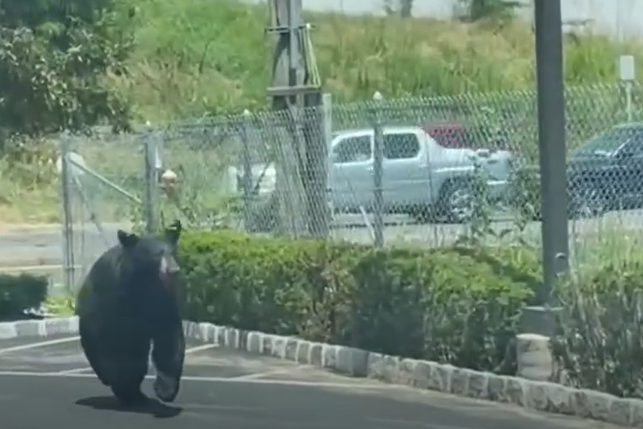More bears here? Less space and scarce food make sightings more likely
It’s not unusual to see bears in the Lower Hudson Valley – home to Bear Mountain and any number of nature preserves.
But drivers were caught off guard when a bear galloped through Nyack’s Dunkin' donuts store drive-thru on July 12, after it emerged from the Interstate 87 embankment and traversed Route 59.
The video, posted to Facebook by Margaret Paulus of Grand View-on-Hudson, was captured around 2 p.m. that day.
"Many people seemed to think the bear was lost," Paulus said. "But it appeared to know just where to go. It went directly to the dumpster, and then when finding it closed, climbed up the hill" between the back of Dunkin' and Upper Depew Avenue.
Paulus said she and her family spend a lot of time outdoors and walk the Esposito Trail with friends. Yet, her first close-up view of a bear was along Route 59.
When she asked the young man working the drive-thru window if bears had come through before, he said no.

Just a week earlier, Greenburgh police reported a very large bear was rummaging around Irvington. Neighbors called with safety concerns.
And on Friday, Bedford Town Supervisor Ellen Calves alerted residents that there had been an uptick in black bear encounters in town.
There don’t appear to be more bears, said Jeremy Hurst, a big-game biologist for the New York State Department of Conservation.
But there’s more development, which means less space for wild animals, and a hotter summer that can further limit food sources.
What's brewing in the Hudson? Bubbling in the river stumps environmentalists
Check you district: Polio vaccinations lag at some schools
988: Why mental health activists raised alarms about new suicide hotline
Hurst said that population may be relatively stable in the Hudson Valley region in general, but there may be more yearlings – younger bears with less experience who are striking out to find their own territory.
“Yearling bears are likely to travel farther, and into more populated areas,” Hurst said. Bear-human conflicts cycle up in even years – like 2022 – Hurst said. He couldn’t pinpoint why, adding that even years produce more cubs so odd years tend to have more yearlings.
“We see some mild reproductive synchrony in bears in the Southeast with above-average pulses of cub production in even years. That creates a slightly larger cohort of yearling bears in the odd years,” Hurst said. “This supports the idea that any increase in bear sightings now is tied more to food issues than population changes.”
When it comes to reducing human-bear conflicts, the impetus is on the humans.
“Frequently, humans unknowingly create potential food sources for bears,” Hurst said. “This may attract bears into close proximity with residential areas and subsequently result in human-bear conflicts.”
The DEC offers these safety tips if you do encounter a bear:
Never approach, surround or corner a bear. Bears aggressively defend themselves when they feel threatened. Be especially cautious around cubs as mother bears are very protective.
Never run from a bear. Stay calm, speak in a loud and calm voice, slowly back away and leave the area.
Use noise to scare away bears from an area like a campsite. Yell, clap or bang pots immediately upon sighting a bear near your campsite.
The best way is for humans to avoid attracting bears in the first place. “Most conflicts with bears in New York can be resolved or minimized by removing or adequately securing whatever served to attract them,” Hurst said.
Remove bird feeders, lock trash cans, clean off barbecue grills and keep pet food inside.
The most common items that attract bears to residential areas are food sources like unsecured garbage, bird feeders, feeding pets outside and messy grills.
And of course, keep watch on the doughnuts.
Nancy Cutler writes about People & Policy. Click here for her latest stories. Follow her on Twitter at @nancyrockland.
This article originally appeared on Rockland/Westchester Journal News: Black bears coming to crowded suburbia amid limited space and food

